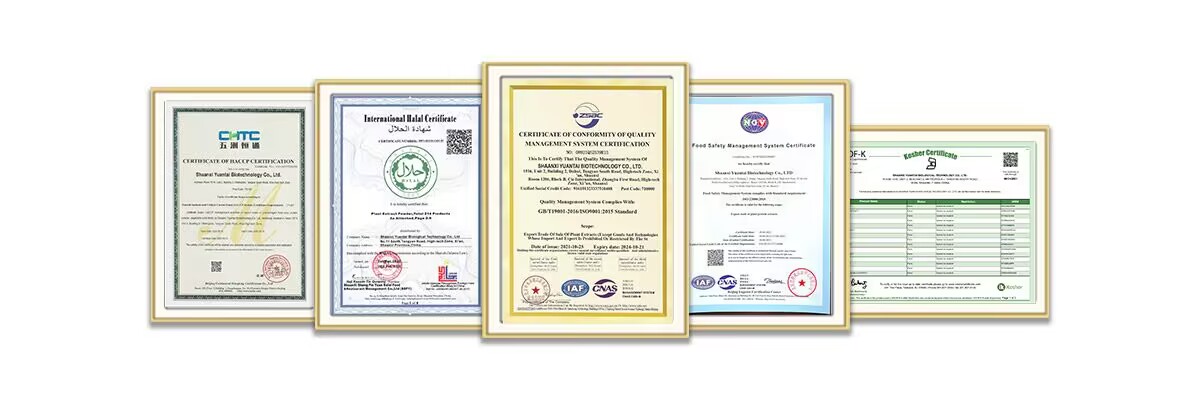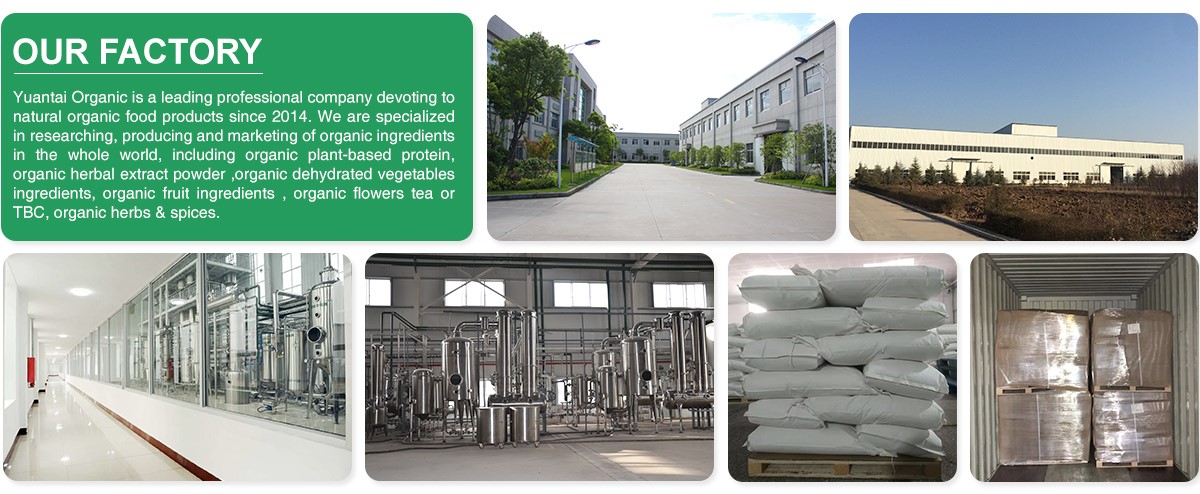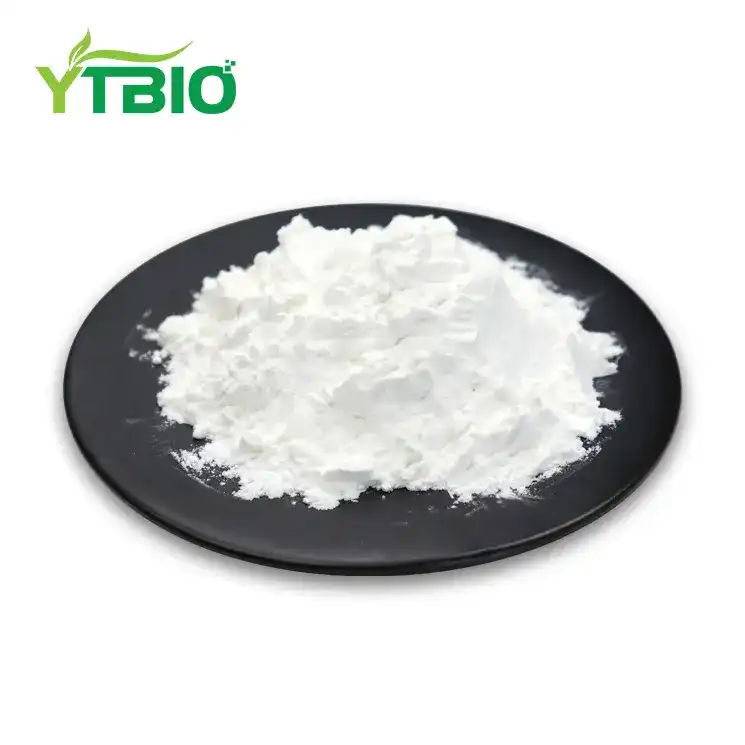Allantoin powder
EINECS: 202-592-8
Chemical formula: C4H6N4O3
Molecular weight: 158.12
Boiling point: 283.17°C (rough estimate)
Melting point: 230 °C (dec.) (lit.)
Density: 1.6031 (rough estimate)
Flash point: 230-234°C
Certification: EU&NOP organic certificate, ISO9001, ISO22000, Kosher, Halal, HACCP
Delivery speed: 1-3 days
Stock: In stock
Payment method: T/T, VISA, XTransfer, Alipay...
Shipping: DHL.FedEx, TNT, EMS, SF, sea freight, air freight
- Fast Delievery
- Quality Assurance
- 24/7 Customer Service
Product Introduction
What is Allantoin powder?
Allantoin powder is a white crystalline powder that is soluble in hot water, hot ethanol and dilute sodium hydroxide solution, slightly soluble in water and ethanol, and almost insoluble in butyl ether and chloroform. It is an imidazole heterocyclic compound, a derivative of uric acid, and a natural component of human skin. As an antioxidant, uric acid reacts with free radicals to produce allantoin. Some plants such as tobacco seeds, wheat seeds, beets, wisteria flowers and Boraginaceae also contain allantoin. Since the traditional process of extracting natural allantoin from natural animals and plants is very low, the process is complicated, and the cost is too high, it cannot be used on a large scale. Therefore, chemical synthesis methods are mainly used to extract synthetic allantoin, such as urea glyoxylic acid direct condensation method, acetic acid calcium hydrochloric acid dissolution method, urea dichloroacetic acid heating method, oxalic acid electrolysis glyoxal oxidation method, trichloroacetaldehyde synthesis method, etc.
It can promote cell tissue growth, metabolism, and soften stratum corneum protein. When applied to ulcerated and suppurated skin, these properties are particularly obvious, so it has the effect of accelerating wound healing and is a good active agent for treating skin damage.

Pharmacological mechanism:
1. Activation of imidazoline receptors
Imidazolin receptors are the main receptors for clonidine and other imidazolines. There are currently three known subtypes of imidazoline receptors, namely I1, I2 and I3 receptors, of which I2 receptors are divided into two subtypes, I2A and I2B. Activation of I1 receptors is believed to regulate blood pressure and have an inhibitory effect on hypotension. The main subcellular localization of I2 receptors is on the mitochondrial membrane, and has neuroprotective and pain-resistant effects.
Allantoin has chemical properties similar to guanidine derivatives, which have the ability to activate imidazoline receptors. Therefore, it is also considered to be an agonist of imidazoline receptors. Studies have shown that it can activate three subtypes of imidazoline receptors and play different pharmacological roles in them. It can activate the I1 receptor of HepG2 cells, increase the expression of farnesoid X receptors, reduce the accumulation of white adipose tissue and energy intake, thereby alleviating hyperlipidemia and ultimately improving liver fatty degeneration. In studies on the treatment of diabetic rats, it was found that allantoin can improve insulin sensitivity, enhance the release of β-endorphin, and thus lower blood sugar.
2. Improve energy metabolism
The effect of improving skeletal muscle energy metabolism has long been mentioned in the study of hypoglycemic effect after I2 receptor activation. Further studies have shown that allantoin can upregulate the expression of MyHC protein and RNA, thereby promoting the differentiation of myoblasts into myotubes. At the same time, it can also activate AMPK/acetyl-CoA carboxylase (ACC) phosphorylation, and upregulate mitochondrial biogenesis-related regulatory factors such as peroxisome proliferator-activated receptor γ coactivator 1α (PGC1α), nuclear respiratory factor-1 (NRF-1), mitochondrial transcription factor A (TFAM) and silent information regulator 1 (Sirt-1), promote GLUT-4 expression, and increase the uptake of glucose and ATP production in myotubes to increase energy production, thereby preventing skeletal muscle dysfunction.
3. Anti-oxidative stress
It is one of the end products of purine catabolism and oxidation of uric acid, and it exhibits anti-oxidative stress effects in many diseases. Studies on the mechanism of anti-oxidative stress have shown that it can interact with free radicals and act as an effective antioxidant in the reaction of reactive oxygen. It can activate the Sirt-1/nuclear factor E2-related factor 2 (Nrf2) pathway in liver cells, while increasing the expression of superoxide dismutase (SOD), catalase (CAT), and glutathione catalase (GSH), thereby reducing the oxidative stress response and lipid peroxidation of liver cells and improving metabolism-related fatty liver disease.
4. Anti-inflammatory
It has anti-inflammatory effects in various disease studies. Experiments have shown that it can effectively reduce the pain response and inflammatory response of mice. In the study of the treatment of asthma, it was found that the expression of Th2 cytokines (IL-4, IL-5) can be reduced in a dose-related manner, inflammation and eosinophil enrichment can be reduced, and the proliferation of airway goblet cells and mucus secretion can be reduced, thereby alleviating asthma symptoms.
Role in skin care products

1. Moisturizing and anti-allergic effects
It promotes the water absorption capacity of the outermost layer of skin and hair, forms a lubricating film on the skin surface, seals the moisture, and thus achieves the effect of skin moisturizing, which can save the skin from a dry and uncomfortable state. As an anti-allergic agent, it can relieve the irritation of active substances to the skin.
2. Moisturizing and repairing effect
It has a moisturizing effect, especially for chapped and rough skin, it can restore its smoothness and moisture. At the same time, it can enhance the water absorption capacity of the outermost layer of skin and hair, improve the hydrophilicity of keratin molecules, repair the damaged stratum corneum, and restore its natural water absorption capacity.
3. Softening keratin effect
It has a unique keratin-dissolving property, so it has the effect of softening keratin. While stripping off metabolic waste keratin, it fills the cell gap with water to make the skin moist and shiny.
Main uses:
1. Medicine
It has physiological functions such as promoting cell growth, accelerating wound healing, and softening keratin. It is a good healing agent and anti-ulcer agent for skin trauma. It can be used to relieve and treat xerosis, skin ulcers, psoriasis, and has a good therapeutic effect on osteomyelitis, diabetes, cirrhosis, and acne.
2. Cosmetics
It is an amphoteric compound that can combine with multiple substances to form complex salts. It is widely used as an ingredient in freckle cream, acne solution, soap, toothpaste, hair conditioner, astringent, anti-moisturizer and other products. Adding allantoin and its salts has the functions of protecting skin, hair tissue, hydrophilicity, water absorption and preventing water evaporation. It can lock moisture in the skin, keep it moisturized and elastic, and promote skin metabolism. It has the effects of whitening, moisturizing and scavenging free radicals. It is often suitable for people with dry and itchy skin, and the effect is more significant when used in combination with silicone and other emollients.
3. Agriculture
It is an excellent plant growth regulator that can stimulate plant growth. It has a significant yield-increasing effect on wheat, citrus, rice, vegetables, soybeans, etc., and has the effect of fixing fruits and promoting maturity.
Certificates
YTBIO is developing in an all-round way. We have our own factory, quality inspection and R&D team. We are committed to providing customers with the best quality Allantoin powder and services. It is our original intention to let every consumer enjoy high-quality and healthy products. If you have any needs or questions about our products, please feel free to contact us and we will reply you as soon as possible.

Packaging and Shipping


Our Company and Factory

_1737093401309.png)

